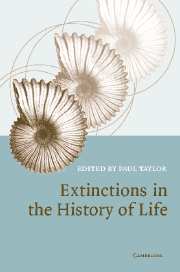Book contents
- Frontmatter
- Contents
- Notes on contributors
- Preface
- 1 Extinction and the fossil record
- 2 Extinctions in life's earliest history
- 3 Mass extinctions in plant evolution
- 4 The beginning of the Mesozoic: 70 million years of environmental stress and extinction
- 5 Causes of mass extinctions
- 6 The evolutionary role of mass extinctions: disaster, recovery and something in-between
- Glossary
- Index
- References
1 - Extinction and the fossil record
Published online by Cambridge University Press: 18 December 2009
- Frontmatter
- Contents
- Notes on contributors
- Preface
- 1 Extinction and the fossil record
- 2 Extinctions in life's earliest history
- 3 Mass extinctions in plant evolution
- 4 The beginning of the Mesozoic: 70 million years of environmental stress and extinction
- 5 Causes of mass extinctions
- 6 The evolutionary role of mass extinctions: disaster, recovery and something in-between
- Glossary
- Index
- References
Summary
INTRODUCTION
The fossil record provides us with a remarkable chronicle of life on Earth. Fossils show how the history of life is characterized by unending change – species originate and become extinct, and clades wax and wane in diversity through the vastness of geological time. One thing is clear – extinction has been just as important as the origination of new species in shaping life's history.
It has been estimated that more than 99 per cent of all species that have ever lived on Earth are now extinct. While species of some prokaryotes may be extremely long-lived (Chapter 2), species of multicellular eukaryotes in the Phanerozoic fossil record commonly become extinct within 10 million years (Ma) of their time of origin, with some surviving for less than a million years. Entire groups of previously dominant animals and plants have succumbed to extinction, epitomized by those stalwarts of popular palaeontology, the dinosaurs. The extinction of dominant clades has had positive as well as negative consequences – extinction removes incumbents and opens the way for other clades to radiate. For example, without the extinction of the incumbent dinosaurs and other ‘ruling reptiles’ 65 Ma ago, birds and mammals, including humans, would surely not be the dominant terrestrial animals they are today.
Over the past 30 years palaeontologists have increasingly turned their attention towards the documentation of evolutionary patterns and the interpretation of processes responsible for these patterns. As part of this endeavour, extinction has become a major focus of study.
- Type
- Chapter
- Information
- Extinctions in the History of Life , pp. 1 - 34Publisher: Cambridge University PressPrint publication year: 2004
References
- 7
- Cited by



